Extreme Territories of Urbanization
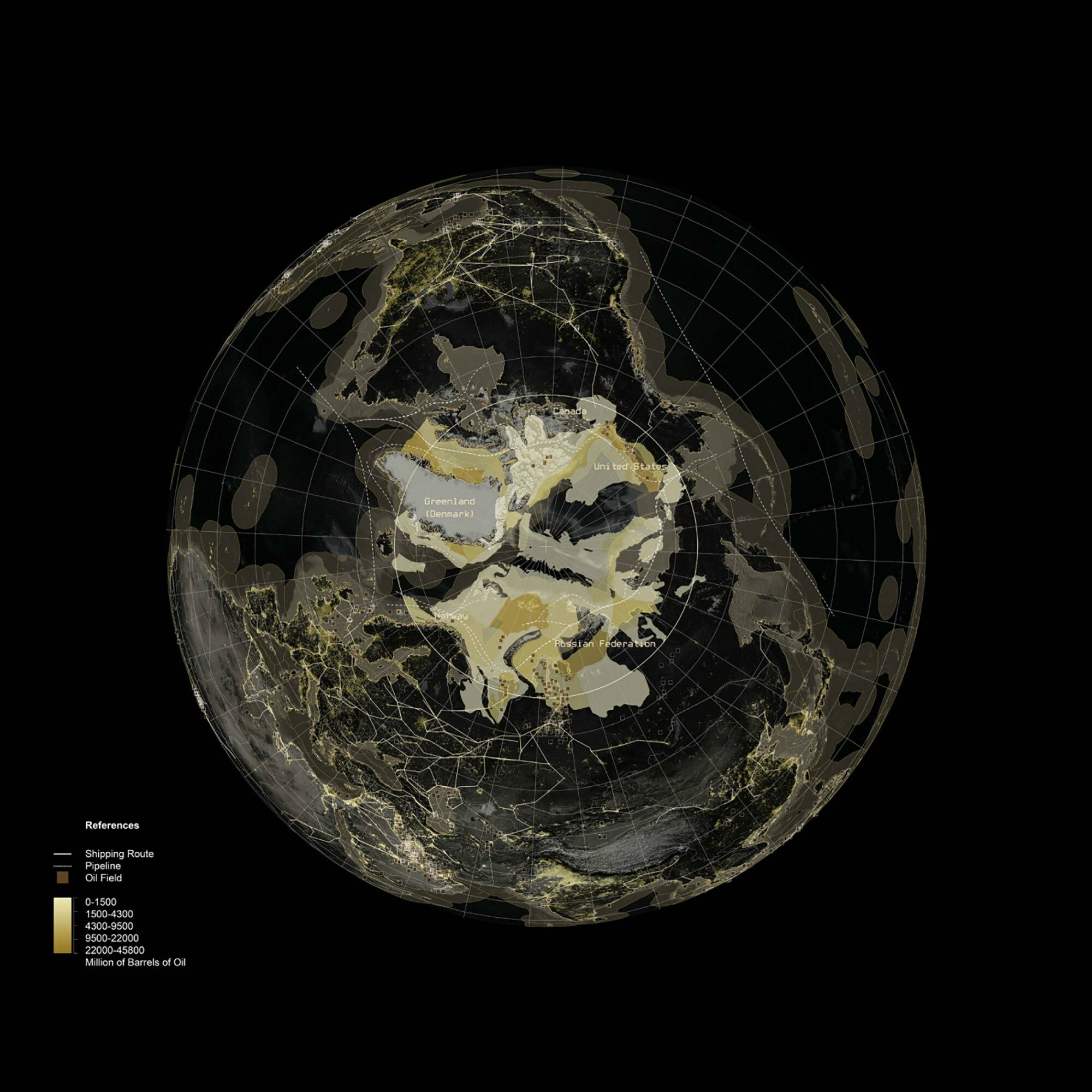
In what sense do we today live in an “urban age”? This idea is frequently invoked by scholars, policy-makers, planners, designers and architects, usually with reference to the proposition that more than 50% of the world’s population now lives within cities. But, can the nature of our urban world be understood and mapped exclusively with reference to the growth of cities and their populations? In our current work, the Urban Theory Lab turns this proposition upside-down and inside-out by speculating on a radically alternative mapping of contemporary planetary urbanization. Rather than focusing our attention on large population centers, we investigate urbanization from the point of view of its putative “outsides,” the zones that are commonly represented as rural, remote, wild and/or untouched by human impact. What happens to our cognitive map of the global urban condition if we focus not on the global cities or mega-cities of the world, but on the wide-ranging sociospatial and environmental transformations that are currently unfolding in supposedly “remote” or “wilderness” regions such as the Amazon, the Arctic, the Gobi desert steppe, the Himalayas, the Pacific ocean, the Sahara desert and Siberia, and even the earth’s atmosphere? To what degree are such zones now being integrated within a worldwide fabric of urbanization? How are they being restructured and enclosed to support the energy, water, material, food and logistics needs of major cities? Through a combination of historical analysis, critical geopolitical economy, geospatial data visualization and conceptual experimentation, this research aims to extend the analytical and political horizons of urban theory into these “extreme territories” of urbanization. This exhibition presents work in progress produced through several research studios organized by the Urban Theory Lab at the Harvard Graduate School of Design.
| Director | Neil Brenner |
| Curatorial team | Mariano Gomez Luque, Daniel Ibañez |
| Research, cartography, video | Grga Basic, Chris Bennett, Kian Goh, Daniel Ibañez, Nikos Katsikis, Mariano Gomez Luque |
| Site-specific research and visualization | Dalal Musaed Al Sayer, Chris Alton, Grga Basic, Shirin Barol, Chris Bennett, Matthew Brown, Chris Buccino, Michael Chieffalo, Danika Cooper, Rob Daurio, Vineet Diwadkar, Tamer Elshayal, Leif Estrada, Ali Fard, Ghazal Jafari, Conor O’Shea, Melany Sun-Min Park, Marianne Potvin, Ana María Quiros, Roi Salgueiro, Adam Tanaka, James Whitte |
| Support provided by | Office of the Dean, Harvard GSD; Weatherhead Center for International Affairs, Harvard University; Milton Fund, Harvard University. |
Extended urbanization is the dominant sociospatial form of contemporary capitalism; it spreads beyond cities through networks that penetrate every regional space, integrating them into a worldwide fabric.
Roberto Luís Monte-Mór
The Amazon has long served as a colonial supply zone for key commodities—oil, minerals, cattle, rubber, soybeans, pharmaceutical supplies. In recent decades, impelled through a combination of neoliberal policies, the growing economic integration of Latin America and the worldwide boom in prices for primary commodities, new urban infrastructures have been threaded across the region: highways, dams, mines, pipelines, railroads, agro-industrial complexes, power plants and multimodal logistics hubs.
The Amazon has become a strategic territory and corridor within the global urban fabric. It's urban fabric is being dramatically thickened in support of global urbanization.

Contemporary cities are entropic black holes sweeping up the productivity of a vastly larger and increasingly global resource hinterland and spewing an equivalent quantity of waste back into it.
William E. Rees
Despite popular representations of the Arctic as a largely depopulated zone of ice, snow and polar bears, any number of large-scale infrastructures crisscross the territory and link it to global circuits of production, circulation, exchange and consumption: ports, military bases, research stations, mines, pipelines, offshore drilling platforms and highways. Meanwhile, the acceleration of climate change opens up new opportunities for ‘accumulation by degradation’ (Leigh Johnson): new shipping lanes, new sources of fossil fuels and new economies of financial speculation.
The strategic / speculative space of the Arctic: oil fields, projected oil reserves, pipelines and shipping routes.

The Earth’s entire surface is urbanized to some degree, from the Siberian tundra to the Brazilian rainforest to the icecap of Antarctica, perhaps even to the world’s oceans and the atmosphere we breathe.
Edward Soja and J. Miguel Kanai
Over a century ago, Georg Simmel famously speculated on the disastrous consequences that would ensue if Berliners’ pocket-watches were simultaneously to stop working. Today, the everyday coordination of urban life hinges upon far more distant technological infrastructures: satellites, which are positioned at various altitudes ranging from 600 to 35,000 km above the earth’s surface. Once dominated by the military, the appropriation of the atmosphere is now increasingly organized through private corporations, which produce the logistical capacities on which urban life depends. This also hinges upon specifc terrestrial infrastructures: a global network of launch sites through which the atmosphere can be accessed and operationalized.
The earth’s atmosphere has been transformed into a field of logistical coordination in support of urban life.
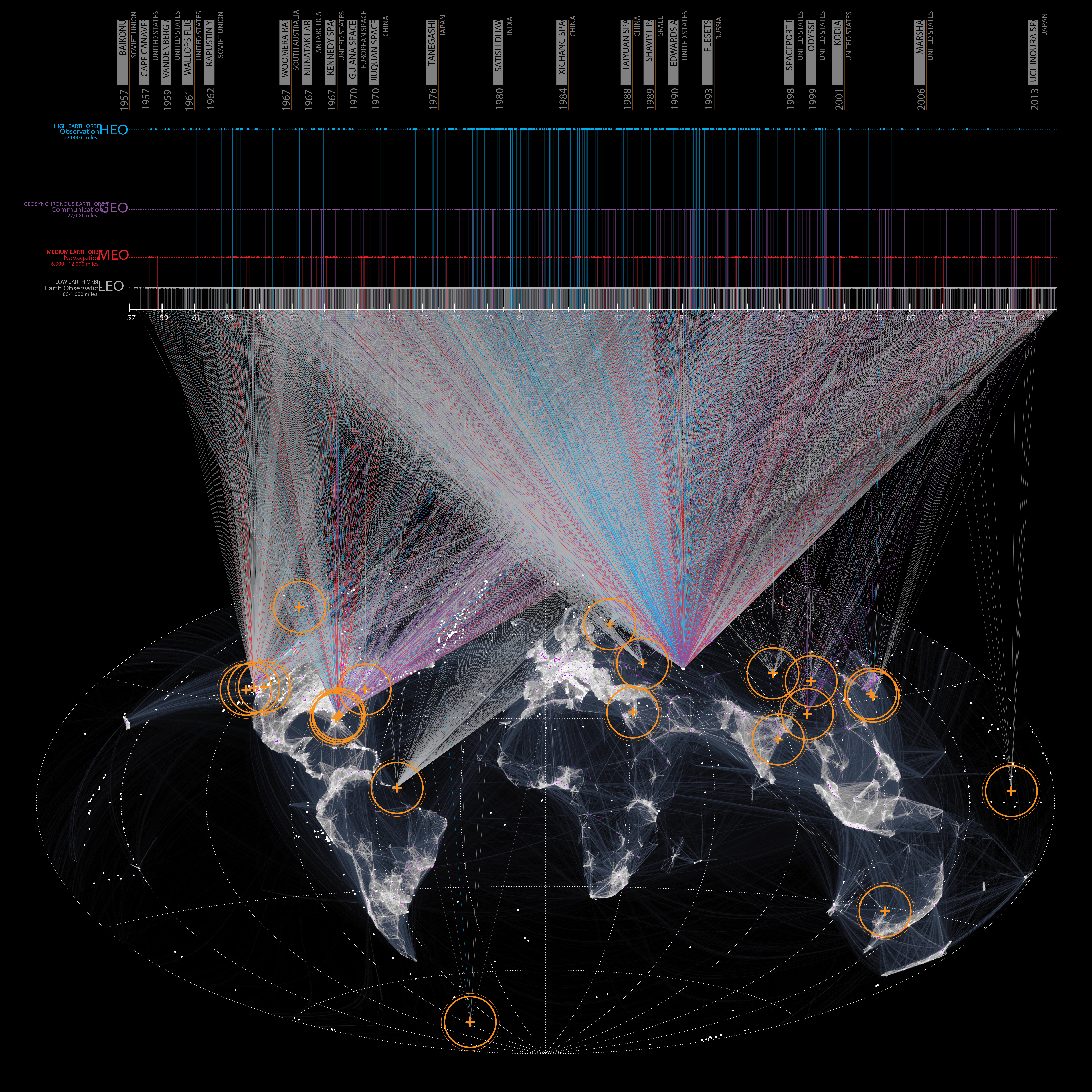
Cities are vast interconnected systems designed for turning energy into ‘work’ or motion, flowing along their roads, rails, wires and pipes […] Concentrating human activities in high-energy cities means increasing the level of disorder, waste and pollution for the planet as a whole.
Herbert Girardet
The Gobi desert steppe is one of the most important sites of resource extraction in Asia, providing the majority of coal imports to neighboring China. The construction of new infrastructures for extraction and transportation, coupled with accelerated flows of capital and labor in the post-socialist period, reflect this strategic role. At the same time, environmental degradation is blurring the urban/rural divide: over-farming, over-grazing, deforestation and depletion of groundwater storms in northern China, while seriously undermining air quality in large cities such as Beijing. In an attempt to prevent Beijing from “becoming Gobi,” the Chinese government has instituted large-scale geo-engineering projects to counteract desertification far afield.
Is Beijing Gobi? Is Gobi Beijing? Social, economic and environmental conditions in these zones are today increasingly interconnected.
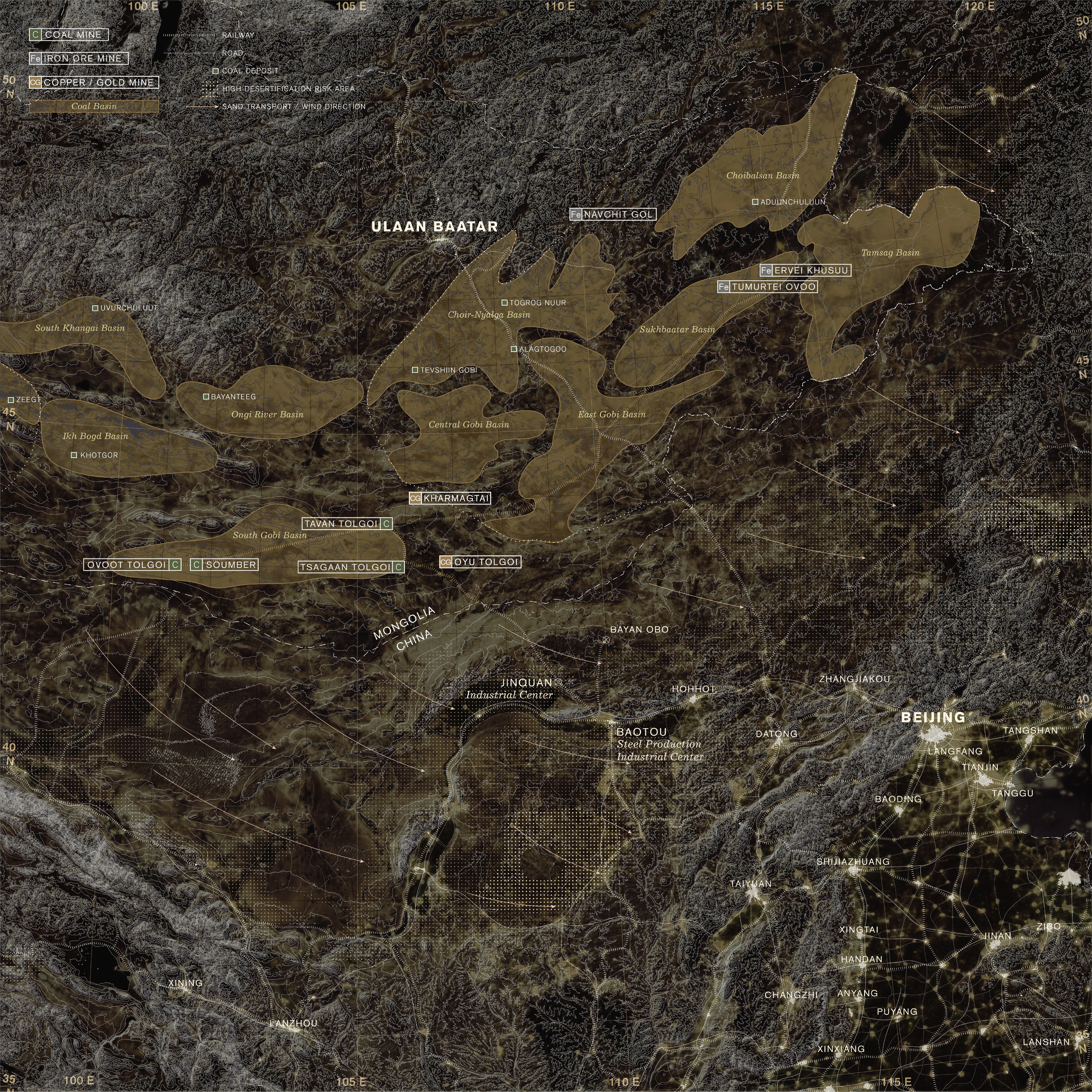
The urbanization of the world is a kind of exteriorization of the inside as well as interiorization of the outside: the urban unfolds into the countryside just as the countryside folds back into the city.
Andy Merrifield
According to Maria Kaika, dam construction signals ‘the perpetual expansion of the city’s ecological footprint.’ While this dynamic has been operative across the Himalaya range for several decades, it has intensified and accelerated during the post-1980s period with the liberalization of the Indian and Chinese economies. As urban systems have expanded across South Asia and China, the demand for hydroelectric power has dramatically escalated, and so too have the irrigation needs of proximate agricultural territories. Across the Himalayas, therefore, hundreds of new dams are being planned, and with them new infrastructural networks— transmission lines, aqueducts, substations, irrigation canals and railways—connecting them to centers of urban industrial activity.
The Himalayas are today being “infrastructuralized”: transformed into a giant hydroelectric machine to support urban growth in India and China.
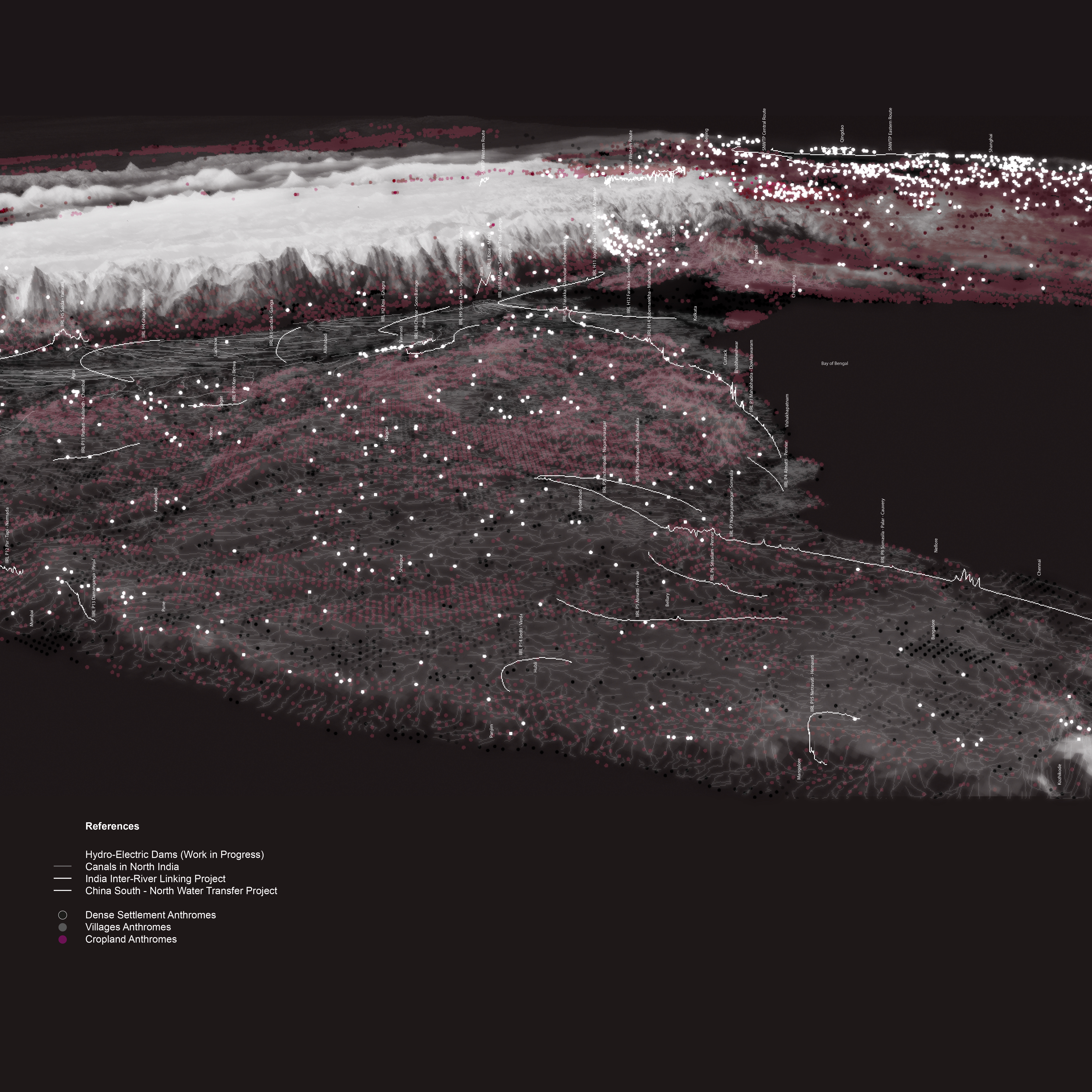
Immense logistical spaces are always carved out beyond, beneath or behind the flows of urban existence. They help produce the permanent quarters of urban space.
Timothy Luke
Like other global oceans, the Pacific Ocean has long been a zone of intense commercial activity bordered by major port cities. Although it is still commonly imagined as a watery void, the Pacific is today being transformed through a range of political-economic processes that support urban growth along its coastlines and far beyond them. The water's surface is crosscut by thickening corridors of container shipping; it has also become a global dumping ground for huge mounds of plastic and other forms of urban waste. New infrastructures of extraction–for fish, minerals, oil and natural gas–traverse the water's volume and seabed. Are non-terrestrial environments such as the oceans becoming spaces of urbanization?
Hardly an empty void, the Pacific today serves as shipping corridor, geoeconomic forcefield, mine and waste dump.
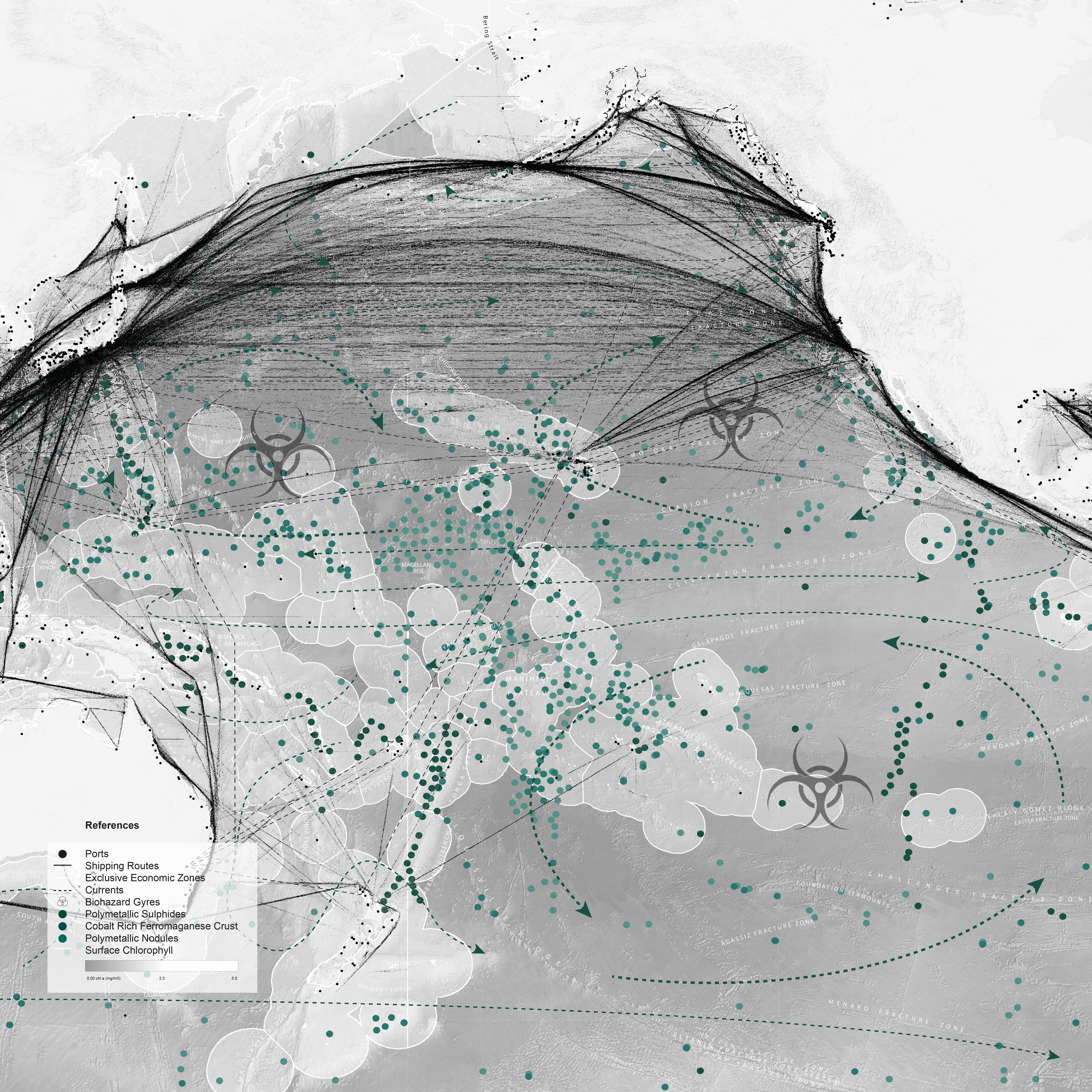
We should not only examine urban forms, but must embed them within broader urbanization processes and their uneven rhythms. A certain form identified and analyzed today might be completely transformed or may even have disappeared in a few years’ time.
Christian Schmid
Since
the 1960's, oil and gas infrastructures have been woven across Siberia;
at that time, they mainly supported the cities of he USSR and allied
states. Following the collapse of the USSR and an initial wave of
privitization, the major firms associated with these sectors–including
LUKoil, ROSFNET and Gazprom–have been re-consolidated under (neoliberal)
state control. Despite post-Soviet geopolitical volatility,
their operations are being expanded (for instance, to Aakhalin, Vankor
and the Arctic), joined to those of major transnational corporations (BP
and ExxonMobil) and reoriented towardsurban energy markets in Europe
and Asia. Siberia's already heavily industialized urban fabric is thus being unevenly
rewoven in a new geoeconomic context.
In post-Soviet times, Siberia's infrastructures for the extraction/transport of fossil fuels are being redirected to support urbanization in Europe and Asia.

